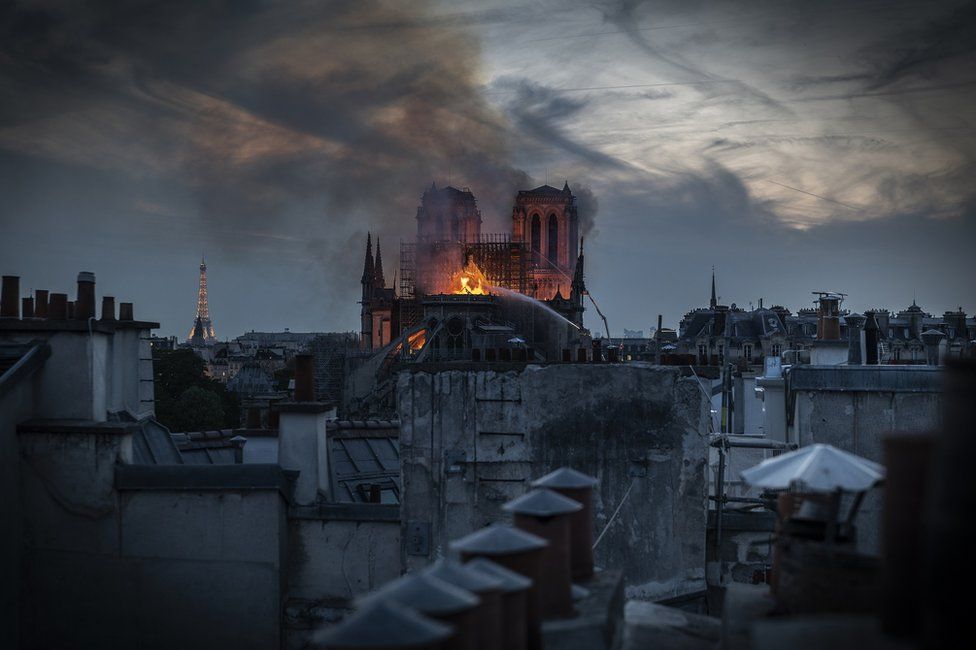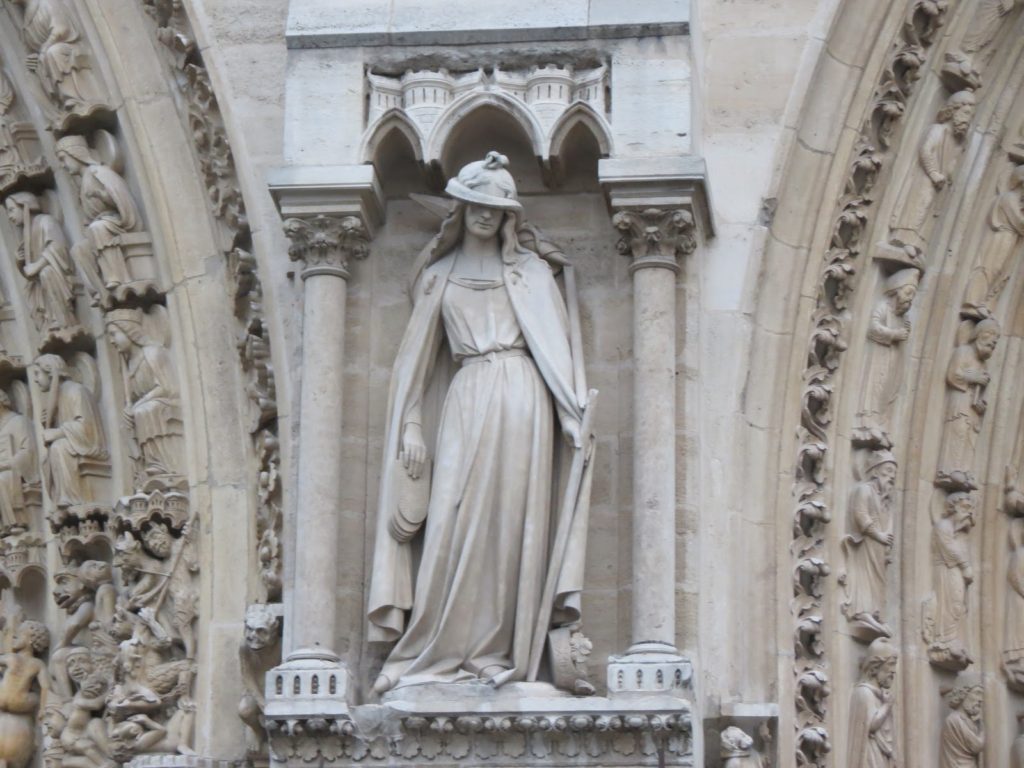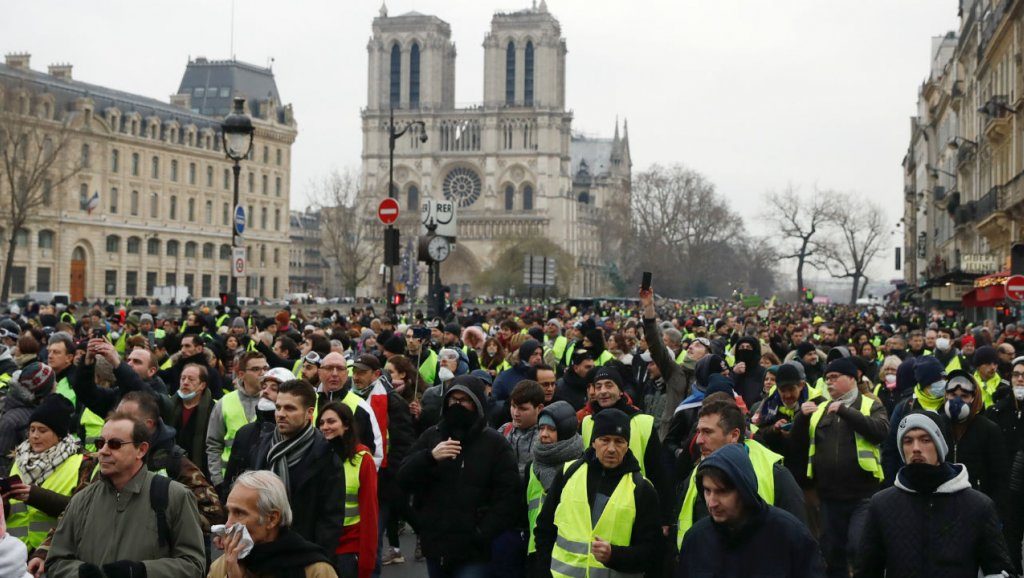The Notre-Dame Fire and France’s National Reconstruction Project
Will repairing Notre Dame reinforce the inequality it has long-represented?

(Veronique De Viguerie/Getty Images)
On the warm summer days of 2009 and 2010, while conducting research in Paris, I would often meet friends along the banks of the Seine River surrounding the Notre-Dame Cathedral. The structure’s awesome presence and enticing shapes—the rounded curve of its apex, its pointed roof, its solid square bell towers, and the finesse of its flying buttresses—made for an extraordinary backdrop to what amounted to a public happy hour. With a bottle of rosé and plastic cups in hand, my friends and I would weave our way through the crowds to find a patch of grass or pavement. The atmosphere was congenial and relaxed and would last well into the evening and night. At times, however, I found this backdrop more unsettling than idyllic. I spent some of my days engaging in discussions about heritage spaces in France, speaking with architects and urban planners who lamented conservative resistance to their bids to design a more sustainable city. I was becoming cognizant of how protecting a certain “image” of France could also serve to support rather exclusionary politics. At times, informed by these conversations, in an unusual mode of ethnographic inquiry, I would find myself inspired to approach those around me, enjoying their drinks along the Seine, to ask them why they thought Paris had to look the way that it did, and what it was that made the Cathedral so central to the Parisian landscape.[1] Friends who accompanied me did not always enjoy this portion of the evening when, admittedly, a few glasses of that rosé may have helped to fortify my courage and loosen my tongue, but I quickly learned that passions surrounding the Catholic space that stood at Paris’s city center ran deep.
The research I conducted during those years set out to ask why ostensibly secular Paris still seems to need Catholicism. In posing this question I did not aim to explore why people continue to be religious in a secular age. Such questions tend to be motivated by a secularization thesis long ago dismissed as irrelevant. Rather, I was interested in the politics surrounding desires for and attachments to Catholic practices and material forms in a nation that famously imposes strict limits on signs of Islam. In other words, why did those I met along the banks of the Seine—most of whom admitted to rarely entering a church—insist upon the centrality of Catholic material forms in their city’s skyline? I primarily came to see these attachments as an expression of the privilege of Catholicism in France. While signs of Islam are maligned as excessively religious and, thereby, deemed inappropriate in the public sphere, Catholic material forms are able to stand in as cultural, historical, heritage, and even secular. But it is not only the privilege of Catholicism that is maintained by the affections surrounding its material culture. Catholic material forms, such as the Notre-Dame, are also used in service of maintaining and reproducing other forms of privilege in France, including class privilege.
The continued relevance of these questions struck me when, having just returned from my annual trip to Paris (where I stayed within easy walking distance from the cathedral), I watched in shock from a Manhattan doctor’s office waiting room as fire ravaged the cathedral’s pointed roof and nineteenth century spire. Reactions to the blaze reiterated many of the claims I heard throughout my time in Paris, as pundits equated the Cathedral with French culture and European civilization. In order to understand the full implications of Notre-Dame’s symbolic importance in France, however, I argue that the shocking sums promised by the families owning many of France’s luxury brands to restore the widely beloved site may be even more significant than the unsurprising ease with which commentators fell back on familiar tropes. Among the innumerable references I encountered in numerous global media to the Notre-Dame as an “icon” of every from Paris to civilization itself, was a New York Times article published the day following the fire, calling these wealthy families “another symbol of the country, thanks to names such as Dior, Louis Vuitton and Saint Laurent.” Nations are, of course, multi-faceted, but in the aftermath of the fire it was intriguing to see how the central symbols of a country widely admired for its Revolution and its laïcité (secularism) appeared to be medieval Catholicism, luxury brands, and startling wealth inequality.
While François-Henri Pinault, the chairman of luxury brand company Kering, was the first to announce his support to the tune of 100 million Euros, in a seemingly purposeful attempt to upstage his rival, Bernard Arnaut, who chairs the LVMH group, announced the next day that he would provide 200 million Euros toward efforts to rebuild the Cathedral. The Times listed the icons associated with the group with easy familiarity:
LVMH is the largest luxury group in the world. Its fashion holdings include Celine, Dior, Givenchy and Louis Vuitton. The group also owns drinks [sic] brands including Moët & Chandon, Dom Pérignon and Veuve Clicquot, as well as the landmark Parisian stores Le Bon Marché and La Samaritaine. The group reported revenue of 46.8 billion Euros in 2018.
Beyond eliciting admiration for their goodwill and charity, luxury brands have other more concrete benefits to glean from a monumental reconstruction of the Notre-Dame. Maintaining the pristine beauty of central Paris does much to help buttress the connection between the brands held by these families and experiences of luxury. Images of Paris abound in their advertising. The coherent architectural forms imposed under the Second Empire and the efforts of Baron Haussmann—which included the construction of numerous neo-gothic churches—help to make the city the most photographed and visited in the world. Many donors will also be eligible for a tax cut equivalent to 60% of their donation. In response to a public outcry about the hit to public coffers, Arnault explained that his family had already maxed out on deductions. He also complained about the problem of “jealousy,” and suggested that, rather than being critiqued, “in other countries we’d be congratulated.”
France’s Catholic material forms, however, may also contribute to reproducing the socioeconomic inequalities that uphold the market in luxury items and experiences. I argue that the city’s innumerable Catholic spaces aid in aestheticizing the inequalities that France failed to overthrow with its Revolution of 1789. The extraordinary distinctions between lives of privilege and wealth and those of labor and poverty in France—not to mention between its citizens of different religious faiths, and between black and white citizens—constantly belie the regime of equality that was supposed to follow from the Revolution. These inequalities were even more amplified in France’s colonial empire. Protests held in France d’outre-mer (the former colonies now included in the French nation through various modes of limited sovereignty) in the past decade have pointed to the immorality of extravagant profit of a few in the face of the poverty of many.
Some of France’s national inequalities are inscribed in more literal terms upon the façade of the Notre-Dame itself. In a recent visit to the Strasbourg cathedral museum, I read one of the information panels about the figures of Synagoga and Ecclessia that frame the entrance to that medieval edifice. Describing the sculpture as the “Vanquished Synagogue and the Church Triumphant,” the museum acknowledged that these had been recognizable Christian symbols since about the eighth century, but it was only in the early thirteenth that they began to adorn the portals of numerous French cathedrals. Describing the Strasbourg Cathedral’s version of this sculpture, the museum lauds the beauty of these symbols.

Synagoga on the facade of the Notre Dame Cathedral
On the left, the Church Triumphant, wearing a crown and holding in her hands a chalice and a banner surmounted by the cross, fixes her self-assured gaze on the Synagogue. The latter, blindfolded and holding a broken lance, averts her head, expressing her inability to recognize the Messiah in the person of Jesus. She appears to let fall the tablet of the Law of Moses, symbolizing the supplanting of the Old Testament. But the extreme humanity and beauty of the young woman’s features suggest an awaited revelation rather than the stigma of blindness.
In the version on the Notre-Dame in Paris, a serpent rather than a piece of cloth blinds the synagogue.
The apparent viscerality of the Notre-Dame’s medieval forms—as well as numerous other medieval Catholic structures in Paris, such as the neighboring Collège des Bernardins (the core subject of my research)—allows Parisians to imagine they remain materially connected to the medieval past. The distance between the past and the present is not entirely overcome, however. Revering and preserving these buildings allows for two contradictory relations to the encounters with the past. First, as a relic of a history now passed, visitors are able to note the differences between the past and present and celebrate the historical inequalities overturned by the Revolution. Second, however, by encouraging awe and admiration of its forms, Catholic heritage spaces forge a connection to that past and provide an aesthetic ground for the distinctions that remain. They allow inhabitants to prefer some forms of inequality, such as those between Muslims and Catholics, or rich and poor, over others, such as those between priests and the laity, or kings and peasants. The grounding of France’s distinctions in material and aesthetic forms thereby refuses the need to push toward greater equality.
The political work accomplished by the enormous gifts made in support of the Notre-Dame becomes all the more evident when one remembers the event that had to be canceled the night of the blaze: President Macron’s belated response to the Gilets Jaunes (Yellow Vests), the leaderless movement made up of tens of thousands of primarily poor and working class people who are demanding a more equitable distribution of wealth in France. According to reports in the centrist paper Le Monde, the President of the Fifth Republic had prerecorded the speech and, instead of airing it as planned at eight o’clock in the evening—or at any point since—simply tweeted “Notre-Dame is beset by flames. The whole nation mourns. Thoughts go out to all Catholics and all French. Like all our compatriots, I am sad tonight to see that part of us burn.”

A Gilets Jaunes protest passing Notre Dame in January 2019.
On the day before the fire, Macron had offered a few hints about his Gilets Jaunes speech. When compared to the speech he gave on the parvis of the Notre-Dame just before midnight as firefighters finally managed to subdue the flames, those hints suggest that Macron might see the burning of the Notre-Dame as an opportunity to forego the far more significant national reconstruction project imagined by the Gilets Jaunes.
At a government meeting on Sunday, April 14 (the day before the fire), according to the article in Le Monde, Macron explained that he hoped to address the Gilets Jaunes “not by multiplying ‘categorical or individual’ measures,” which he described as “an impasse.” Instead, he aimed to “redefine” the “national project. The time we are entering is that of redefining the national and European project.” By Monday night, in front of the dramatic backdrop of a Notre- Dame still aglow, however, Macron emotively explained that another national project now demanded the nation’s attention. “And so I say to you tonight, with great solemnity, we will rebuild this cathedral. All together, it is without a doubt a part of the French destiny and the project that we will have for the years to come.”
In a speech the following evening, the President clarified that now—in a moment when, with remarkable ease, several of France’s most profitable companies managed to gather together nearly $1 billion to support Macron’s “new” national project—was not the time to ask questions about inequality. “I will return to the subjects with which I was engaged with you in the days to come so that we can act collectively following our Great Debate,” Macron glossed.[2] “But today is not the time; tomorrow, politics and its tumults will take back their place, we all know that. But the moment has not yet come.” In his brief speech, he even went so far as to suggest that such inequality was necessary to the national project, insisting that “the rich, like those less rich have given money, each according to what they could give, each in their place, each in their role.” Such statements ring of the Catholic theology of personalism, a mode of viewing the human person as a member of a community in which a variety of differences and inequalities are not only acceptable, but also desirable.
As Macron implicitly acknowledged, the critiques made of his neoliberal government—by far the most committed to a pro-business agenda in France in recent years—are unlikely to be so easily dismissed. Indeed, the following Saturday the Gilets Jaunes were in the streets again, expressing their disgust that such enormous funds could so easily be accessed to support an ailing building but not a suffering population.
And yet, that Macron’s attempt to replace the reconstruction of French society along more equitable terms with a national project to reconstruct the Cathedral appears even momentarily plausible suggests that those of us interested in the place of material religion in contemporary life need to more fully address the kinds of politics such forms can support. Material religious forms are not only a means by which to make God present, they are a means by which to make certain fantasies about the past present. As its destruction during the Revolution and massive reconstruction in the nineteenth century reveal, this has been one of the primary functions of the Notre-Dame Cathedral—and many other Catholic spaces throughout Paris—since at least the nineteenth century.
I do not want to argue that the Cathedral should not be fixed. What will be fascinating to watch in the years to come, however, is the kind of debates its rehabilitation or reconstruction provokes. As the restoration plans develop, we should watch to see if maintaining the Notre-Dame as an icon of the medieval period remains a priority. What kind of political will would be necessary for those interested in reconstructing the Cathedral to take this opportunity to rethink the inequalities both forged into its stones and maintained by its privileged place in the Parisian landscape? If such questions were to be posed might they open the way to others? If the Notre-Dame is indeed the icon of France, its Kilometer Zero, the use to which the renovation project is put—as a means by which to reproduce or to confront the inequalities and privileges it symbolizes and maintains—may indeed have a great deal to say about the nature of France in the present.

The kilometer markers on all of France’s highways allow travelers to know how far they are from the Notre-Dame–kilometer zero–at all times.
***
[1] These questions are related. The Cathedral as well as the city underwent extensive renovations in the nineteenth century, allowing the Cathedral’s monumental status to be amplified, while also making it appear more at home within the remarkably coherent architecture of the city center.
[2] In response to the Gilets Jaunes protests, in the early months of 2019 the President held a number of listening sessions throughout the country, which he entitled the “Great Debate.” The speech on Monday was to include a list of policy and political measures to address the concerns that arose in the “debate.”
***
Elayne Oliphant’s scholarship explores the privilege of Christianity in France and Europe. She rethinks the evolutionary tale of religious to secular by examining the ongoing (and ever-transforming) dominance of Christian signs and symbols in the public sphere. She has published essays exploring the privileged circulation of Christian signs in contemporary art exhibits, museum displays, and European Court of Human Rights rulings. She is currently completing her first book entitled The Art of the Unmarked: The Privilege of Catholicism in 21st Century Paris. Her current research projects include: developing a political theology of the “commons” as a means of addressing the debts that forge the social; researching various “commons” projects in the United States and France, including the Gilets Jaunes protest movement.
***
Published with support from the Henry R. Luce Initiative on Religion in International Affairs.